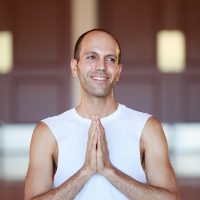Let’s face it: the quality of most yoga instruction today leaves a lot to be desired.
Quality control is lacking, standards are low, and students are suffering. Commercial yoga “styles” are teaching from scripts, and instructors are not trained in principles of alignment, classical theory, or right intention.
These deceptively simple tips are intended to help instructors consistently improve the quality of their classes, but students can also benefit from applying them to their personal practice and to their intention in class. May our practice be genuine, so that it benefits all and harms none.
1. Always Re-Mind the Breath
Asana (posture work) without mindfulness of breath does not lead to yoga. Breath is the liaison between the body and the mind, and as such it is the main emphasis, the location, the home of yoga. Every movement and posture can be yoked to and enlivened by the breath.
Always begin with reference to the breath, and invite the mind back to the breath throughout the practice. Never hold a pose; always call upon the breath to bring inner movement to every posture so that it is fluid and alive, rather than stiff.
When you think that the body is at its limit, disbelieve your thoughts. If you give the inhalation a chance to expand the body’s limits by softening, even momentarily backing off of capacity’s edge (see tip number two), the exhalation may reward you with the disappearance of perceived limitations.
Teaches, remember that English is wonderfully unique in that it allows us to use “inhale” and “exhale” as transitive verbs, taking an object. In English, we can say “inhale the right leg back” without it meaning literally swallowing your leg, as it would in many languages. That’s a powerful force—use it. You can verbally help your students yoke every gesture to the breath in this way, with great rewards for their practice.
2. Dance on the Edge of Capacity
Some teachers are good at reminding students not to push the edge. Others are good at inviting students to question and challenge their limitations. Both views are right and both views, independent of each other, are limited and limiting.
Asana practiced aggressively does not lead to yoga. Asana that stays a safe distance from anything whatsoever also does not lead to yoga. This is because yoga is full integration with no exception, and staying away from our edges will keep them in the dark.
That which is in the light is already in the light. That which comes easily is of no interest to yoga practice. Yoga practice is not intended to highlight and celebrate our excellence; it is here to reveal, to spotlight our weaknesses and fears, our laziness and pettiness, and to transform our understanding of these shadows by demonstrating that these, too, are made of light. Go patient and brave to the edges that lie in the shadow, and you will find yoga.
Yet any desire to banish, to annihilate, even to “free oneself” from the shadow is misguided, and it can—and in most of our modern “styles”, it does—lead to unnecessary and harmful aggression. Never try to beat the edge with a sledgehammer. The maharaja of yoga dances joyously on the edge of capacity. Let the spanda of breath, the eternal frequency of expansion and contraction, set a rhythm for dancing around the edge and you may find that it softens, perhaps even that is was never really there.
3. There’s Always Time to Mind Alignment
It baffles me how little alignment is taught in most classes that go by the name of yoga. I often go to classes with famous and illustrious teachers and leave saddened, even outraged, at the endangerment of bodies and waste of precious time.
Iyengar and Anusara teachers are usually an obvious exception to this, but these styles often fail to seduce the distracted minds of students raised on video games and speed-cut music television. Teachers who meet their students where they are will be rewarded with success, and there is nothing essentially wrong with giving students the pleasure of flow that most of them so desire. Yet this has led to an inordinate amount of fluffy and aerobic classes that do little for the mind.
Always mind the alignment of the body. Drawing the mind into the body via the breath is the very essence of asana practice, and there is always time to mind alignment.
Teachers, by all means give your students flow. You will fatigue their distractedness and cut a path to their hearts. Yet also sharpen your mind and your skills of teaching alignment no matter the tempo. There is always time to draw mind to the lower abdomen, to the medial arches of the feet, to the bases of the index fingers and the thumbs.
Teach. If you don’t know what every part of the body should do in every gesture, don’t teach it until you do. If you don’t know where to turn to learn, find me and I’ll happily help.
Yoga is the complete alignment of body, breath and mind, beyond the self, even at the edge of the capacity of body, breath and mind. If your teachers’ insights into yoga are not in alignment with each other, their teaching—or your understanding—are not yet complete.
Learn until you know. Ask until you are clear. Practice until you feel whole.
Like elephant yoga on Facebook.
Ed: Sara Crolick










Read 2 comments and reply